Page 108 of 340
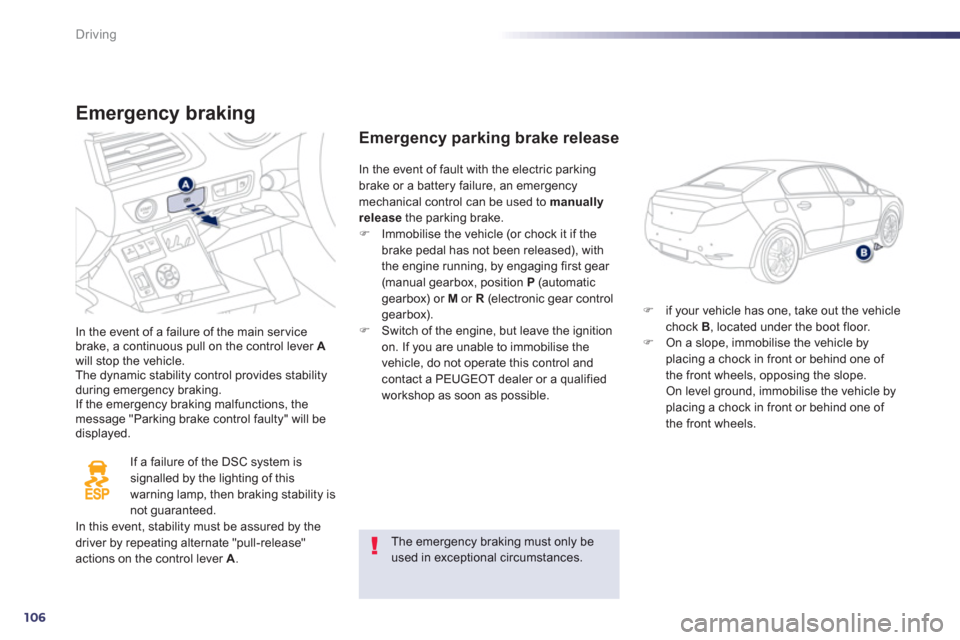
106
Driving
Emergency braking
In the event of a failure of the main servicebrake, a continuous pull on the control lever Awill stop the vehicle.The dynamic stability control provides stability during emergency braking.
If the emergency braking malfunctions, themessage "Parking brake control faulty" will be displayed.
If a failure of the DSC s
ystem is
signalled by the lighting of this
warning lamp, then braking stability is
not guaranteed.In this event, stability must be assured by thedriver by repeating alternate "pull-release" actions on the control lever A.
Emergency parking brake release
�)if your vehicle has one, take out the vehicle chock B , located under the boot floor. �)On a slope, immobilise the vehicle byplacing a chock in front or behind one of
the front wheels, opposing the slope. On level ground, immobilise the vehicle byplacing a chock in front or behind one of
the front wheels.
In the event o
f fault with the electric parkingbrake or a battery failure, an emergencymechanical control can be used to manually
releasethe parking brake.�) Immobilise the vehicle (or chock it if the
brake pedal has not been released), with
the engine running, by engaging first gear (manual gearbox, position P(automatic gearbox) or M or R(electronic gear control
gearbox). �) Switch of the engine, but leave the ignition on. If you are unable to immobilise the
vehicle, do not operate this control and
contact a PEUGEOT dealer or a qualified
workshop as soon as possible.
The emergency braking must only be used in exceptional circumstances.
Page 123 of 340
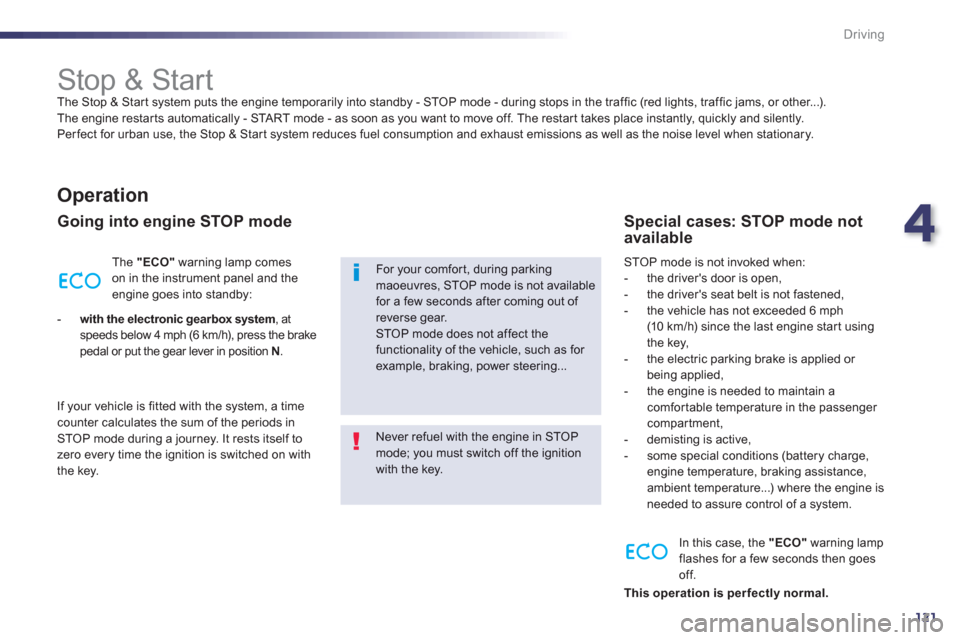
4
121
Driving
Stop & Start
The Stop & Star t system puts the engine temporarily into standby - STOP mode - during stops in the traffic (red lights, traffic jams, or other...).
The engine restar ts automatically - START mode - as soon as you want to move off. The restart takes place instantly, quickly and silently.
Per fect for urban use, the Stop & Star t system reduces fuel consumption and exhaust emissions as well as the noise level when stationary.
Operation
Going into engine STOP mode
The "ECO"warning lamp comes
on in the instrument panel and the
engine goes into standby:
-
with the electronic gearbox system, at speeds below 4 mph (6 km/h), press the brakepedal or put the gear lever in position N.
I
f your vehicle is fitted with the system, a timecounter calculates the sum of the periods in
STOP mode during a journey. It rests itself to
zero every time the ignition is switched on with
the ke
y.
Never refuel with the engine in STOPmode; you must switch off the ignition with the key.
For your comfort, during parking maoeuvres, STOP mode is not available for a few seconds after coming out of reverse gear. STOP mode does not affect the functionality of the vehicle, such as for example, braking, power steering...
Special cases: STOP mode notavailable
STOP mode is not invoked when:
- the driver's door is open,
- the driver's seat belt is not fastened,
- the vehicle has not exceeded 6 mph (10 km/h) since the last engine star t using
the key,
- the electric parking brake is applied or
being applied,
- the engine is needed to maintain acomfor table temperature in the passenger compartment,
- demisting is active,
- some special conditions (battery charge, engine temperature, braking assistance,
ambient temperature...) where the engine isneeded to assure control of a system.
In this case, the
"ECO"
warning lamp
flashes for a few seconds then goesoff.
This operation is per fectly normal
.
Page 138 of 340
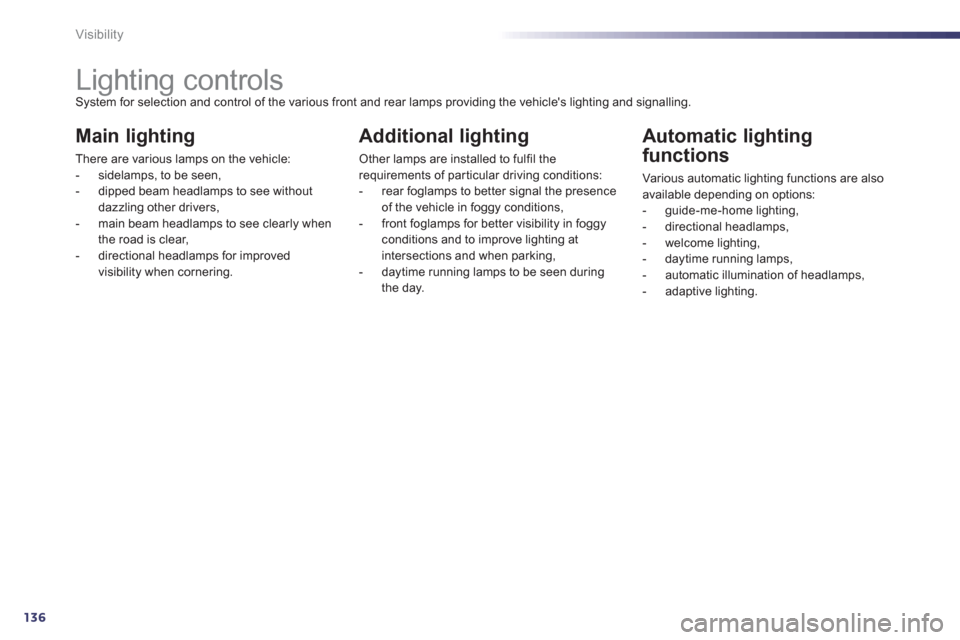
136
Visibility
Lighting controls System for selection and control of the various front and rear lamps providing the vehicle's lighting and signalling.
Main lighting
There are various lamps on the vehicle:
- sidelamps, to be seen,
- dipped beam headlamps to see without
dazzlin
g other drivers,
- main beam headlamps to see clearly when
the road is clear,
- directional headlamps for improved
visibility when cornering.
Additional lighting
Other lamps are installed to fulfil the requirements of particular driving conditions:
- rear foglamps to better signal the presence of the vehicle in foggy conditions,
- front foglamps for better visibility in foggyconditions and to improve lighting at intersections and when parking,
- daytime running lamps to be seen duringthe day.
Automatic lighting
functions
Various automatic lighting functions are also
available depending on options:
- guide-me-home lighting,
- directional headlamps,
- welcome lighting,
- daytime running lamps,
- automatic illumination o
f headlamps,
- adaptive lighting.
Page 139 of 340
5
137
Visibility
Model without AUTO lighting
Model with AUTO lighting
Selection ring for main lighting mode
Turn the ring to position the symbol required
facing the mark.
Li
ghting off.
Automatic illumination of headlamps.
Sidelamps onl
y.
Dipped or main beam headlamps.
Stalk for switching headlamps
Pull the stalk to switch the lighting between
dipped / main beam headlamps.
In the li
ghting off and sidelamps modes, the driver can switch on the main beam headlamps
temporaril
y ("headlamp flash") by maintaining apull on the stalk.
Displays
Illumination of the corresponding indicator lamp
in the instrument panel confirms the lighting switched on.
Page 140 of 340
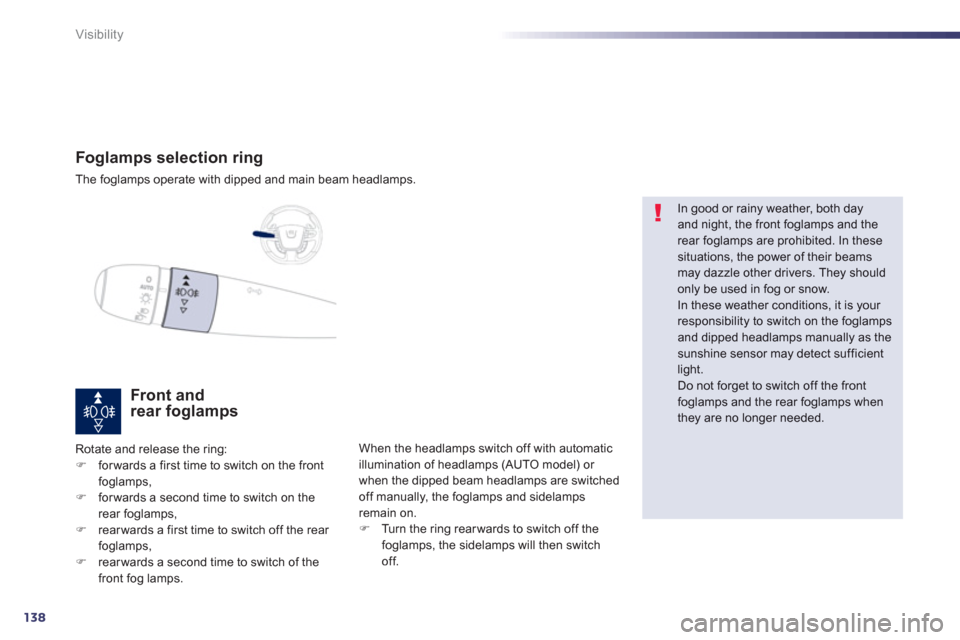
138
Visibility
Foglamps selection ring
The foglamps operate with dipped and main beam headlamps.
Front and rear foglamps
Rotate and release the ring: �)forwards a first time to switch on the frontfoglamps, �)forwards a second time to switch on therear foglamps, �)rearwards a first time to switch off the rear
foglamps, �)rearwards a second time to switch of the
front fog lamps. When the headlamps switch off with automatic
illumination of headlamps
(AUTO model) or
when the dipped beam headlamps are switched
o
ff manually, the foglamps and sidelampsremain on.�) Turn the ring rear wards to switch off the foglamps, the sidelamps will then switchoff.
In good or rainy weather, both day and night, the front foglamps and the rear foglamps are prohibited. In these situations, the power of their beams may dazzle other drivers. They shouldonly be used in fog or snow.
In these weather conditions, it is your responsibility to switch on the foglamps and dipped headlamps manually as the sunshine sensor may detect sufficientlight.
Do not forget to switch off the front foglamps and the rear foglamps when they are no longer needed.
Page 141 of 340
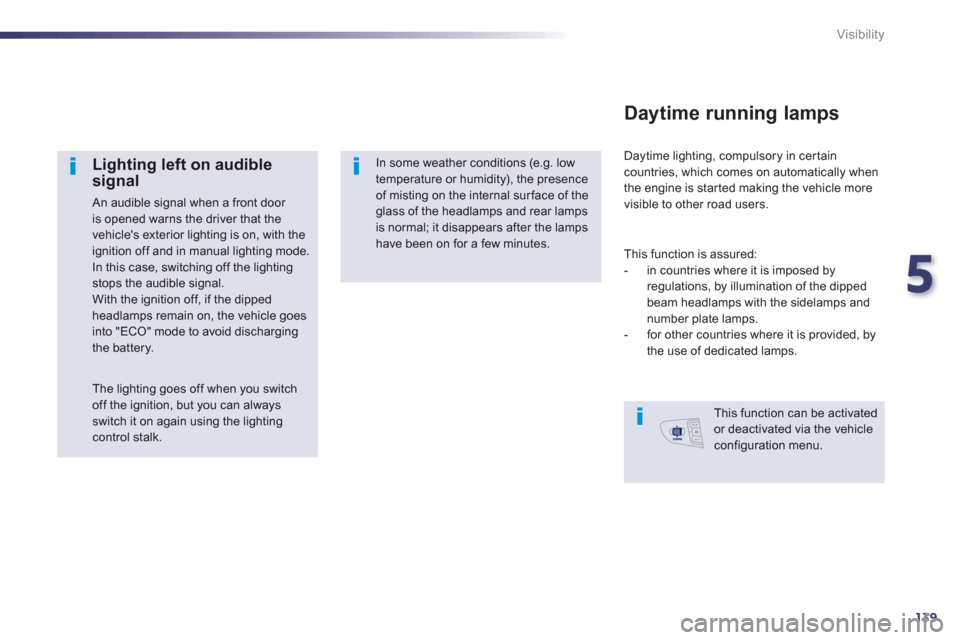
5
139
Visibility
Lighting left on audible signal
An audible signal when a front door is opened warns the driver that the vehicle's exterior lighting is on, with theignition off and in manual lighting mode.
In this case, switching off the lighting stops the audible signal.
With the ignition off, if the dipped headlamps remain on, the vehicle goes into "ECO" mode to avoid discharging the battery.
In some weather conditions (e.g. lowtemperature or humidity), the presenceof misting on the internal sur face of the glass of the headlamps and rear lamps is normal; it disappears after the lampshave been on for a few minutes.
Daytime lighting, compulsory in cer tain
countries, which comes on automatically when
the engine is star ted making the vehicle more
visible to other road users.
Daytime running lamps
This function is assured:
- in countries where it is imposed by
regulations, by illumination of the dippedbeam headlamps with the sidelamps and number plate lamps.
- for other countries where it is provided, by
the use of dedicated lamps.
This function can be activatedor deactivated via the vehicleconfiguration menu.
The lighting goes off when you switchoff the ignition, but you can always switch it on again using the lighting control stalk.
Page 142 of 340
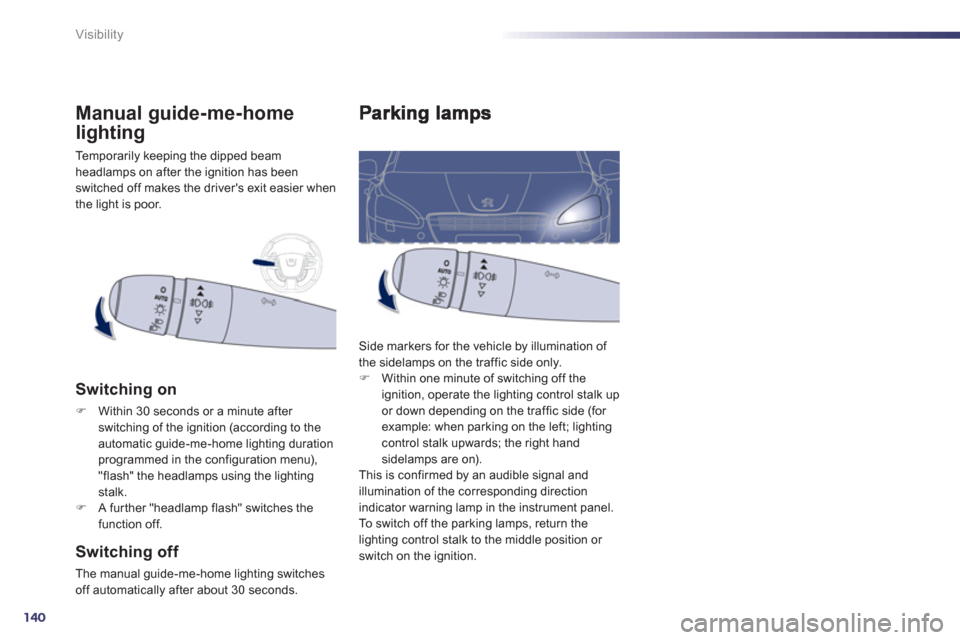
140
Visibility
Side markers for the vehicle by illumination of
the sidelamps on the traffic side only. �) Within one minute of switching off the
ignition, operate the lighting control stalk upor down depending on the traffic side (for example: when parking on the left; lightingcontrol stalk upwards; the right hand sidelamps are on).
This is confirmed by an audible signal and
illumination of the corresponding direction
indicator warning lamp in the instrument panel.
To switch off the parking lamps, return the
lighting control stalk to the middle position or
switch on the ignition.
Temporarily keeping the dipped beam
headlamps on after the ignition has beenswitched off makes the driver's exit easier when
the light is poor.
Manual guide-me-home
lighting
Switching on
�)Within 30 seconds or a minute after
switching of the ignition (according to theautomatic guide-me-home lighting durationprogrammed in the configuration menu), "flash" the headlamps using the lighting stalk.�)A further "headlamp flash" switches the
function off.
Switching off
The manual guide-me-home lighting switches
off automatically after about 30 seconds.
Page 143 of 340
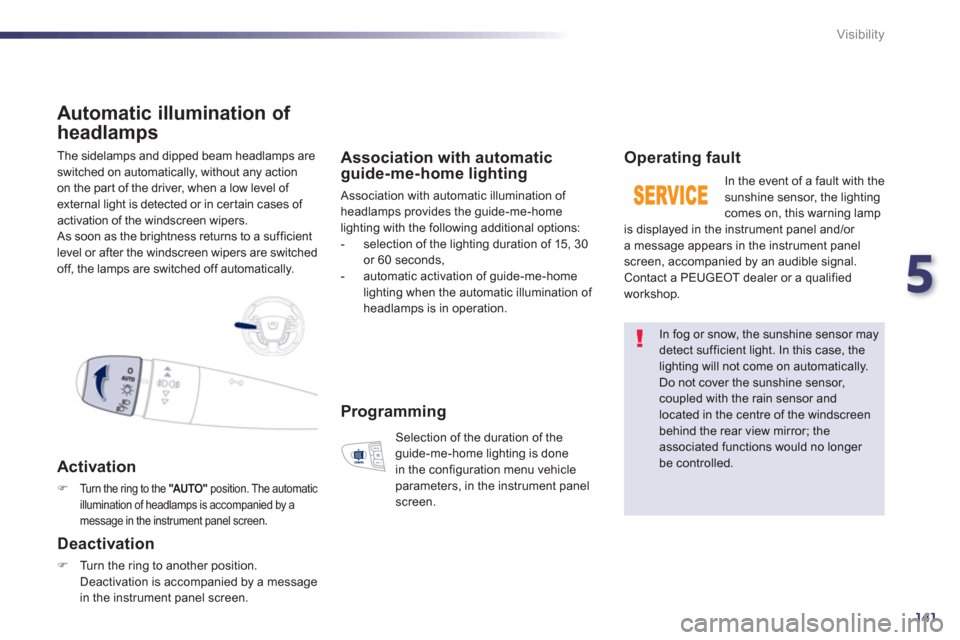
5
141
Visibility
The sidelamps and dipped beam headlamps are
switched on automatically, without any action
on the part of the driver, when a low level of external light is detected or in certain cases of
activation of the windscreen wipers.
As soon as the brightness returns to a sufficient
level or after the windscreen wipers are switched
o
ff, the lamps are switched off automatically.
Automatic illumination of
headlam
ps
Activation
�)Turn the ring to the "AUTO"position. The automatic
illumination of headlamps is accompanied by a message in the instrument panel screen.
Deactivation
�)Turn the ring to another position.
Deactivation is accompanied by a message
in the instrument panel screen.
Association with automaticguide-me-home lighting
Association with automatic illumination of headlamps provides the guide-me-home lighting with the following additional options:
- selection of the lighting duration of 15, 30
or 60 seconds,
- automatic activation o
f guide-me-home lighting when the automatic illumination of
headlamps is in operation.
Operating fault
In the event of a fault with the sunshine sensor, the lighting comes on, this warning lamp
is displayed in the instrument panel and/or
a message appears in the instrument panel screen, accompanied by an audible signal.
Contact a PEUGEOT dealer or a qualified
workshop.
In fog or snow, the sunshine sensor maydetect sufficient light. In this case, the lighting will not come on automatically. Do not cover the sunshine sensor,coupled with the rain sensor and located in the centre of the windscreenbehind the rear view mirror; theassociated functions would no longer be controlled.
Programming
Selection of the duration of theguide-me-home lighting is done
in the configuration menu vehicle
parameters, in the instrument panel screen.